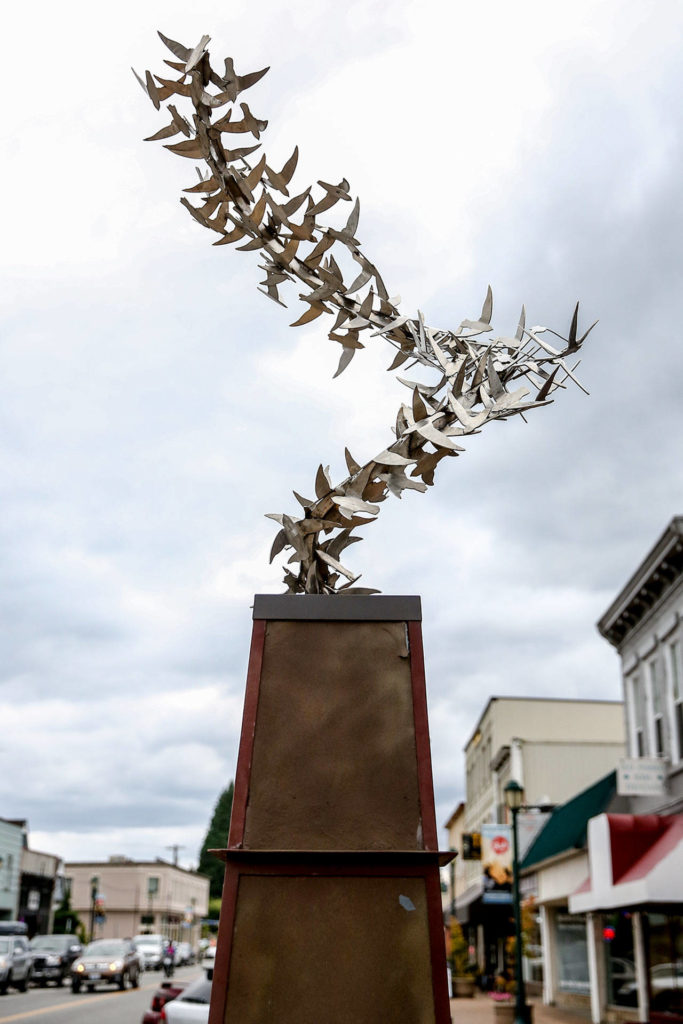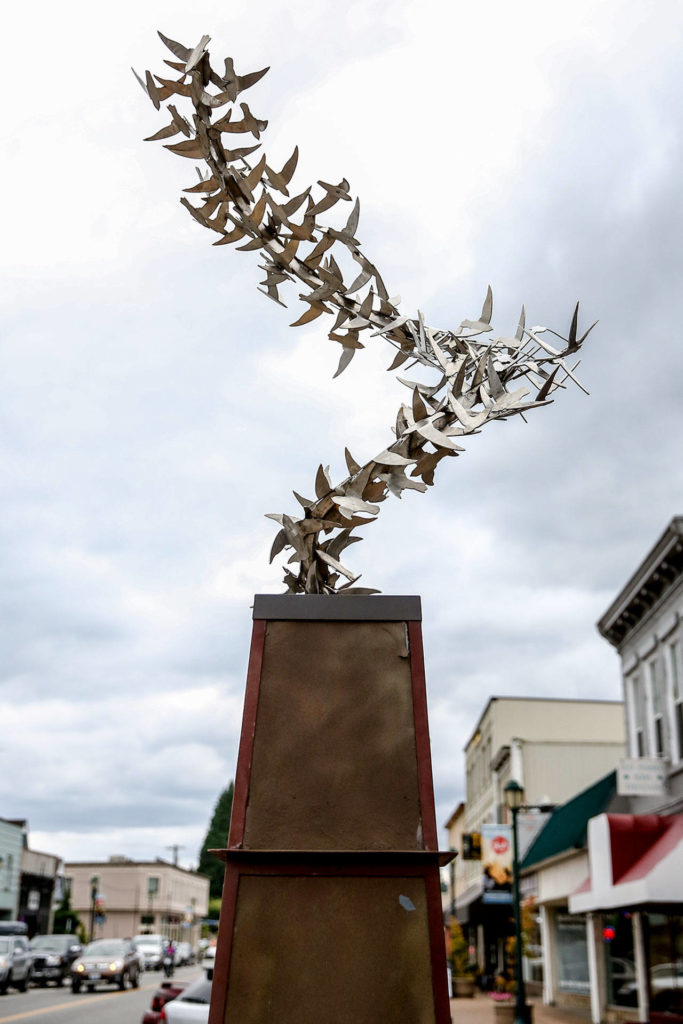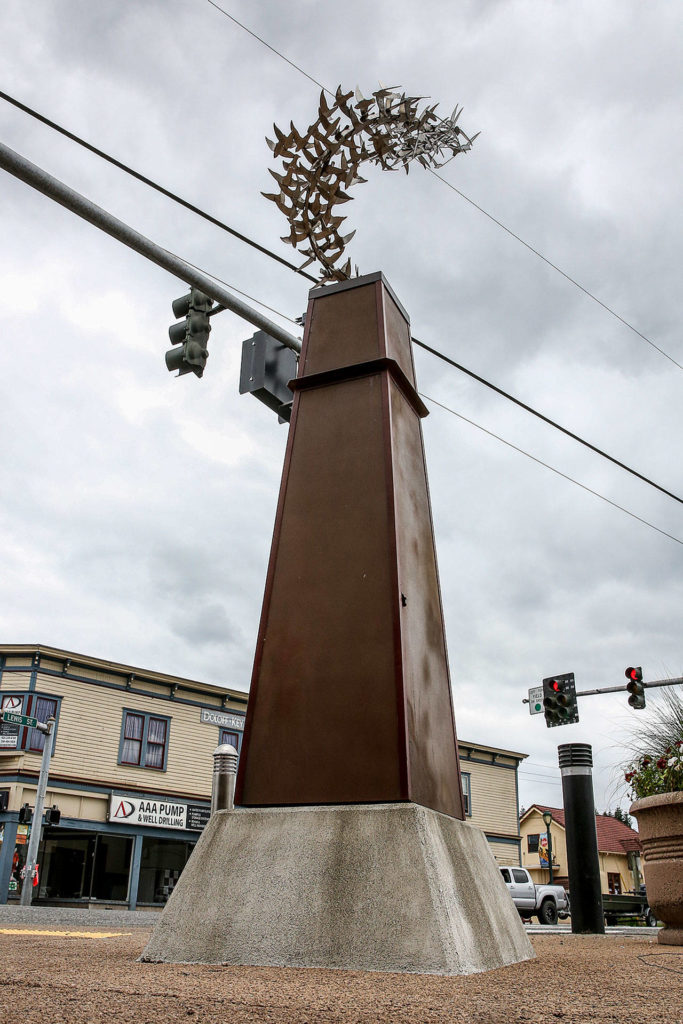MONROE — Thousands of Vaux’s swifts are visiting the old chimney at the Wagner Performing Arts Center this summer — at a time when they shouldn’t be migrating.
Twice a year, around May and September, as many as 26,000 Vaux’s swifts stop to roost at the old chimney on their migration route between Canada and Mexico. It’s one of the largest congregations of the birds in North America.
The brownish-gray birds are not visiting the chimney in those numbers these days, but the count still is unusual, a local Vaux’s swift expert says.
“Now they’re building nests, laying eggs, raising young,” Larry “Dr. Swift” Schwitters said. “But the thing is, on July 1 we had 3,000 of them, and the night before that we had 1,000 in Monroe.”
Though the chimney of the former Frank Wagner Elementary School has swift visitors all summer long, Schwitters has never seen so many roosting there this time of year. In 12 years, the retired science teacher has documented 25 migrations and nearly 15 million roosting swifts.
On June 12, 3,000 Vaux’s swifts stayed the night in Monroe. There were 6,000 counted on June 13. On June 15, 10,000 birds tucked themselves in for the night. Another 2,000 showed up to roost on June 27.
“Those are big numbers,” he said. “There shouldn’t be that many swifts; they shouldn’t be migrating through.”
He said they’re not mating in Monroe: There has never been a nest built in this roost, at least not in the last 13 years.
Any time he sees numbers over 1,000 by mid-June, Schwitters said it has to do with the rain. When it rains, all the Vaux’s swifts within 50 miles of each other flock to Monroe to sleep together. The rain also brings out swarms of insects.
He has a theory: “If there are swarming insects that the rain brings out, probably flying ants or termites, then that brings in Vaux’s from all over, and if it’s still kind of raining, they all roost together in Monroe,” Schwitters said. “The cold and wet brings them in. Wagner must be a short fly from wherever they get their insects.”
Schwitters added, jokingly: “If I was that sort of scientist, I would write a paper on it.”
Schwitters founded the Vaux’s Happening Project in 2007 to help save the Wagner’s chimney. The Monroe School District planned to tear it down. District officials feared an earthquake; the Pilchuck Audubon Society feared loss of an important migratory roost site.
In 2009, the Audubon was granted $100,000 from the state to pay for a seismic retrofit for the roost. With the renovations, the chimney built in 1939 can not only withstand earthquakes but cameras were installed to monitor the birds.
“The chimney has real good bricks and mortar in it,” Schwitters said. “So it was structurally sound to start with.”
Statue celebrates ‘ballet in the sky’
The Vaux’s swift was named Monroe’s official city bird in 2016.
Then, in 2017, the city issued a call-for-sculptors, asking artists to submit ideas for artwork that represents the character of Monroe. The Monroe City Council unanimously approved sculptor Kevin Pettelle’s “Wagner Swifts” proposal.
The “Wagner Swifts” statue celebrating the chimney and its swifts was erected on Main Street that same year, a half-mile east of Wagner’s chimney.
“When I think of Monroe, I think of these swifts,” Pettelle said. “The fact that they come twice a year to the chimney.”
Pettelle, who was named the Schack Art Center’s Artist of the Year in 2012, was inspired by the swifts’ “ballet in the sky” at the Wagner Performing Arts Center.
At dusk, the small birds swirl into the chimney to roost for the night. As the sun sets, the swifts circle and call out to the others as if to synchronize the dive. Then they pour into the chimney, each of them finding a foothold among the rough bricks, overlapping like shingles inside.
A former resident of Monroe, he and his wife have gone to Swift Night Out in September to see the swirling swifts.
Schwitters met with Pettelle to help him design his swift shapes. His 12-foot sculpture features 100 or so stainless-steel cutouts of the birds in three positions of flight, swirling around the top of a 6-foot base meant to look like the chimney. Each swift was made true-to-size.
Pettelle’s original designs for the statue included 400 stainless-steel birds, but his budget couldn’t afford so many. City officials approved a $10,000 art grant to pay for the project.
He is in the process of refinishing the 6-foot base. It’s been just three years since its installation, but it was in need of some maintenance.
Pettelle said he was in talks with the city about the expansion of “Wagner Swifts” before the coronavirus hit.
He wants to fulfill his vision of 400 swifts swirling into the chimney like a tornado — “I’d like more of a mass there,” he said. In addition to adding three times the number of birds, Pettelle also wants to add a lighting element to make the iridescence of the stainless steel pop after the sun sets.
Birders fight to save large chimneys
With the Audubon, Schwitters, 79, continues to work to preserve their habitat along the flyway. Namely, large chimneys.
Swifts don’t have back talons, so they can’t stand or perch, but their hooked claws and stiff feathers allow them to cling inside hollow trees or old industrial chimneys. The birds only land to roost, nest or to avoid rain.
Because of logging, natural habitat became harder for the swifts to find. So the adaptable bird learned to roost in brick chimneys built in the 1930s and ‘40s. They roost in a string of about 25 chimneys along the Pacific coast.
When those old chimneys are sealed or torn down, Vaux swifts’ numbers decline.
Last year, the Audubon reopened the chimney of a church in Rainier, Oregon. It had been sealed off to the swifts 28 years ago. It’s only seen two migrations, but Schwitters said the roost is already seeing strong numbers. Up to 17,000 swifts were counted there.
“We pulled the grate off and now it’s one of the most important ones in North America,” he said. “We won that one.”
But sometimes saving chimneys just doesn’t work. A 66-year-old fire station with a chimney in Albany, Oregon, that hosted up to 11,000 swifts was torn down in 2016 because of earthquake dangers. The Audubon has tried to attract the displaced swifts to a 30-foot-tall replacement tower three blocks away, but it hasn’t worked yet.
“The swifts haven’t used it, and I don’t think they’re going to,” Schwitters said.
Sunset is swift-watching time
Schwitters said the naming of the Vaux’s swift as Monroe’s official bird and the “Wagner Swifts” statue helps to keep the swifts’ plight in the forefront of the community’s mind.
“This was a bird that 13 years ago the school district didn’t have any interest in at all,” Schwitters said. “They had a very important roost, but they didn’t care. Audubon cared about the birds, and they raised a stink.
“We’ve done a good job of bringing awareness about this bird.”
Swift-watching has become a ritual for Monroe since 2008. But because of the coronavirus, Schwitters said the 13th annual Swift Night Out this September likely will be canceled.
Last year, hundreds gathered on the lawn of the former Frank Wagner Elementary School to watch the swifts swirl into the chimney at dusk.
You don’t have to wait until September to see the Vaux’s swifts tuck themselves in for the night. If the rains continue like they have in June, you’ll still get a good show.
“Bedtime is sunset, unless there is rain,” he said. “If there’s rain, the birds will try to just beat the rain. That may be in the afternoon.”
Schwitters recommends you stop by the Wagner Performing Arts Center an hour before sunset to watch. Stay in your car and wear a mask, he said.
“Don’t expect to see 3,000,” he said. “Because that’s the second most we’ve ever seen in July.”
If you don’t want to drive to the chimney, you can watch a live stream of the Vaux’s swifts at vaux-swift-inside.click2stream.com. Turn up your volume.
Sara Bruestle: 425-339-3046; sbruestle@heraldnet.com; @sarabruestle.
Vaux’s facts
Some cool facts about Vaux’s swifts:
• Vaux’s swifts are named for William S. Vaux, who was a member of the Academy of Natural Sciences. The name is English, not French, and so the X is sounded.
• North America has four species of swifts: chimney, black, white-throated and Vaux’s. Vaux’s swift is the smallest.
• Vaux’s swifts are, indeed, swift. They are among the fastest of all flying birds. A chimney swift was clocked at 69 mph.
• They spend most of their time flying because they can’t stand or perch. They feed, mate and go about nesting all in flight.
• A single swift may consume as many as 20,000 insects in a single day.
• Vaux’s swifts roost communally, by the hundreds and sometimes the thousands, likely to conserve body heat.
• The birds descend into their roost tree or chimney essentially at once, spiraling down in a very dramatic rush at nightfall.
Sources: www.pilchuckaudubon.org and www.vauxhappening.org
Talk to us
> Give us your news tips.
> Send us a letter to the editor.
> More Herald contact information.




























